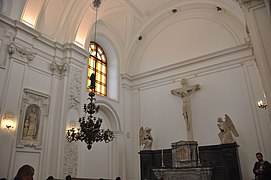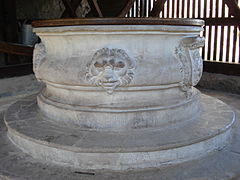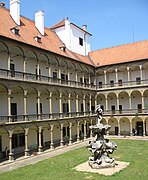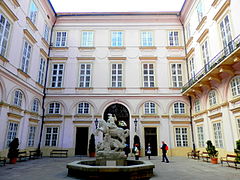Pietro Maino Maderno

Pietro Maino Maderno ( also Peter Matterny, Matern, Materna , * around 1592 in Bissone on Lake Lugano , Ticino ; † March 15, 1653 in Moosbrunn ) was an imperial court sculptor of the Renaissance , member of the Swiss artist family Maderno with architects ( Carlo Maderno ), sculptors ( Stefano Maderno ) and stone masons .
1649 raised Ferdinand III. , Emperor of the Holy Roman Empire , Pietro Maino Maderno and his family for his artistic work in Austria and Hungary in the nobility as provincial knights.
Life
Pietro was born - so to speak - a free Swiss . The stern rule of the monastery of Heiligenkreuz , represented by Abbot Paul Nice Ebner and its managers in the castle royal court , lifelong demanded his freedom aspirations .
He learned the stonemason craft in the Imperial Quarry on Leithaberg , the center of Swiss-Italian architects near Vienna. When imperial master Anthony Tencalla he was in 1605 apprentice. As a journeyman of the Kaisersteinbruch Brotherhood, he was drawn to the most prominent construction site of his time in 1610, St. Peter's Basilica in Rome. Carlo Maderno , a close relative of Pietro, perhaps father / uncle ?, was given the supervision of the construction of the cathedral by Pope Paul V in 1588 ; the facade was completed in 1614.
After Rudolf II's death in Prague, the new Emperor Matthias moved the residence back to Vienna in June 1612. After the years of wandering , Pietro came back to the imperial quarry, the masters Andre Ruffini and Antonius Bregno worked in the Amalientrakt of the Vienna Hofburg , formerly Cillierhof. In 1616 Pietro began additional training as a sculptor. His teacher was the Viennese sculptor Antonius Crivelli , who managed the quarry and bought a small estate.
Request to lease a quarry
In a request of September 27, 1616, Pietro wrote ... "If I would consider a place in the quarry there for the promotion of my handicraft, which Your Grace is subject to ... to break stone out of the intended quarry."
In it he reported to the authorities that he was now fully trained and had the financial means to pay the rent for a quarry and to buy a house. He did not get a quarry, but he was able to buy Margaretha Weingradin's house.
In 1617 Pietro married Victoria Bregnin, widow of Stephano Bregno, master mason, who immigrated from Lugano years ago. He was 25 and she was 29 years old.
Maderno leaves the quarry
From 1621 Maderno worked under the direction of the architect Giovanni Giacomo Tencalla on the construction of the Loreto chapel for St. Anna's Church in Nikolsburg ( stucco work by Giovanni Tencalla, sculptures by Peter Concorz ). The client was Cardinal Franz Seraph von Dietrichstein . Master stonemason Pietro Maderno took Johann , son of master Mathias Lorentisch on as an apprentice in 1624 . Paul Cleritz became his apprentice in 1627, Giorgio Regondi in 1629 and Heinrich Freywiller in 1631 , who had come from Zurich . After five years he was acquitted as a journeyman .
Prince Liechtenstein court sculptor
On December 6, 1632, Prince Karl Eusebius of Liechtenstein commissioned master builder Giovanni Giacomo Tencalla to plan waterworks for the park of his castle in Eisgrub . He called his court sculptor Pietro Maino Maderno to design the Venetian fountain with 4 levels for the water features, “according to the contract he made six fountains in Hrubschitzer stone, as well as balustrades and pedestals.” In the account books of 1610/1611 “ Domenico Maderno , Ihro Fürstliche Grace master builder mentioned.
According to the working agreement of January 15, 1635 "he should make the pedestals for the stone sculptures in the garden at Eisgrub .. the cleanest and most delicate of all figures and fruits on sculptural work ..." The only remaining well, out of a total of 6, is today in the ab "New parks" laid out in 1890 in front of Eisgrub Castle.
In 1635 the Kaisersteinbrucher property of Antonius Crivelli came to Maderno.
Hofburg Amalientrakt, fountain
Nikolsburg , St. Anna Church with Loreto Chapel
Forchtenstein Castle , Brunnen, Kaiserstein
Monumental Bacchus Fountain in the Bučovice Castle
In 1635 Prince Maximilian von Liechtenstein commissioned the construction of a monumental Bacchus Fountain in the arcade courtyard of his Bučovice Palace . Giovanni Giacomo Tencalla drew the plan that Pietro Maino Maderno, Viennese court sculptor, executed in Eggenburger Stein . Above a large basin, the artist tied winged mermaids seated on dolphins to the shaft of a column and arched small basins above them in the heads of the dragon monsters that curled like a volute. He crowned this whole, fantastically overgrown gland with a curved, shell-like bowl with mascarons and the figure of a bacchante , which was taken from the ancient Greek game Askalia.
On November 18, 1636, he leased his own quarry in the Kaisersteinbruch area for the first time.
Klosterneuburg monastery stonemason
Since 1637, the north tower of Klosterneuburg Monastery has grown up according to the plans of Battista Carlone . He had to shape it in every way according to the south tower. Master Maderno was in charge of all the stone carvings, including a cross vault . From the existing calculations it is shown that an average of 50 people (2 sculptors, 23 journeymen, apprentices and day laborers) were employed in the "Maderno Company". After an interruption, on January 11, 1648, a contract was signed for the final completion of the building, which was countersigned by experts from the Wiener Bauhütte, the master stonemason Johann Jacob Pock and the master builder Filiberto Lucchese .
Pressburg, Primate's Palace
Garden palace of Palatine Count Paul Pálffy in Pressburg
At the same time as the renovation of the castle complex in Pressburg , which was headed by Palatine Paul Pálffy , he started his summer residence on Castle Hill in 1636 according to the plan of Giovanni Battista Carlone . For this purpose, he had a garden planned, which was designed by architects and gardeners as a terrace system with long trellises and outside stairs. The highlight of this total work of art was the elaborately designed fountain by the court sculptor Pietro Maino Maderno. In 1641, at the time of completion, these gardens were unique in the Habsburg monarchy . Stone deliveries and stone carvings from the nearby Kaisersteinbruch are documented for both buildings .
Daughter Veronica married the architect Francesco Caratti in Bissone in February 1642 (day illegible) .
Exile of the son Pietro from the quarry
A court case on December 2, 1642, held in Kaisersteinbruch by Abbot Michael Schnabel , determined the further life of Maderno as a father. His son Pietro was accused of murder . The sequence of events, "... the young Maderno fell over him, falling and lying down like that, he gave the meat chopper four fatal stabs with a stiletto ." In fact, the meat chopper had remained lying there as if dead. Abbot decided, “... that he accepted the father's intercession. Nevertheless, it has been recognized that the perpetrator in eternity should no longer enter the quarry and grounds of the Heiligenkreuz Abbey. "A request from the son six years later," ... I feel sorry for such things from the bottom of my heart, my father not me at the quarry want to tolerate until I am pardoned by Your Grace ... ", was refused. There is no further news from Pietro in the quarry. It can be assumed that Maderno brought his son to the family in the homeland. His fight against the authorities began.
Viennese homeowners
In 1644, Master Maderno bought a house in the Viennese suburb of Laimgrube , the house and property " Zur Blaue Andten " near the brick town in front of the Widmer Tor, but continued to work outside Vienna. No tenants lived with him. Due to the tax performance, he counted as a wealthy master.
Imperial court sculptor
Archduke Leopold Wilhelm , younger brother of Ferdinand III, the art-loving Bishop of Passau , asked his imperial court sculptor Pietro Maino Maderno to build a chapel of grace in the Capuchin monastery and near Krems , architect Mattheo Piazoll. The work in Klosterneuburg was interrupted and a court artist had to answer the court's call.
In December 1644, Prince Karl Eusebius von Liechtenstein called Master Maderno to Feldsberg to get him new work. With the architect Francesco Caratti , he built two fountains and a large stone basin. The journeyman Domenicus Morelli from the imperial quarry worked with and was accepted.
Salva Guardia privilege for Kaisersteinbruch
Pastor Andreas Maderno (Materny), Pietro's eldest son
Maria Magdalena Leyserin, daughter of Georg Leyser, a former wagon master, and Mrs. Barbara, unmarried, who worked with master stonemason Pietro Maino Maderno in the kayserl. Steinbruch served as a cook for 6 years, married the widower, schoolmaster Mathias Ländl, on February 12, 1646 in Moosbrunn.
In 1647 he organized the construction of the tower for the Kaisersteinbruch Church . During the years of his work abroad, Master Pietro was repeatedly in the quarry. The incumbent judge Andre Ruffini was more and more isolated from his fellow masters due to his submissive attitude, Maderno became the opposite pole. This was evident in the difficult negotiations with the Viennese Bauhütte in 1644/45 , especially with regard to the rule of the Heiligenkreuz Abbey in secret minutes of the conversation.
Fountain for Archbishop Count Georg Lippay in Pressburg
In the courtyard of the Primatialpalais , the Georg fountain dominates with a life-size stone statue of George on horseback as a dragon slayer , in the middle of a basin. It comes from the once archbishop's, magnificently landscaped garden of Count Georg Lippay (1600–1666), Archbishop of Esztergom , Bishop of Veszprém , Hungarian Councilor and Court Chancellor. Master Pietro worked on this sculpture with his workshop in 1647/48.
Stonemasons from the Leithagebirge merged in 1649 in the Kaisersteinbrucher quarter store
Hurt honor
Marriage in St. Stephen's Cathedral in 1651
In 1648, after Andre Ruffini's death, Maderno took over the office of judge in Kaisersteinbruch . In 1649 he was raised to the nobility for his artistic works in Austria and Hungary.
- In St. Stephen married on April 30, 1651 the ennobled judges, court sculptor, and widowers Pietro M. Maderno in the third marriage Christina Spätzin, born Cook, widow to court master mason Pietro Spazzio from the Italian family of "Spazzio". The girl Christina Koch was born in Kaisersteinbrucher.
The masters of the Kaisersteinbruch stonemasonry
Maderno served as judge from 1649 to 1652, his co-masters in these years were Mathias Lorentisch , Johann Lorentisch , Domenicus Petruzzy , Hieronymus Bregno , Ambrosius Regondi , Giorgio Regondi , Thomas Ruffini.
On December 14, 1651 the brotherhood decided, in order to defend itself against the sale of the quarries to Viennese masters, that no master and journeyman, whoever he wanted, would take care of the master Hans Herstorffer's quarry ...
Confrontation at the consecration
July 30, 1652 Consecration of the Kaisersteinbrucher Church by Abbot Michael Schnabel from Heiligenkreuz Abbey. The brotherhood, led by Judge Maderno, had the imperial heraldic eagle painted on the tower, Mr. Abbot demanded that it be deleted. An undated document in the monastery archive (after August 17, 1652) ends with the words - the erasure did not happen, and has remained standing to this day, after various warnings . Maderno was deposed as judge, Ambrosius Regondi took over the office. He brought charges against the abbot at the Palatine Hill in Pressburg for lese majesty .
death
Pietro Maino Maderno died on March 15, 1653 at the age of 61. Maderno had written a Vienna will and appointed his eldest son Andre, pastor of Moosbrunn , to be the executor. This will was destroyed in the Vienna Palace of Justice fire in 1927 .
Abbot Michael Schnabel from Heiligenkreuz Abbey made important decisions. In future he will not tolerate any “noble subjects” in his quarry. In a letter to his judge Ambrosius Regondi, Mr. Abbot ordered: ... so my serious command to you is that you immediately put away the Imperial Salva Guardia Adler , who was attached to the said master Maderno's blessed dwelling - who was allowed to do so for his entire life and deliver it to my steward at the royal court . An "aristocratic commission" was convened and judged by the stonemasons .
The Viennese house was acquired by master builder Domenico Carlone , the Kaisersteinbrucher property, quarry, house, etc. was sold by the heirs in 1657 to the young master Ambrosius Ferrethi and his wife Agatha, a daughter of master Hieronymus Bregno . A few years later, Carlone and Ferrethi worked on the Leopoldine wing of the Vienna Hofburg .
From around 1550 until after 1700, Kaisersteinbruch was an Italian-Swiss artist colony , and Pietro M. Maderno was a special figure among these stonemasons, sculptors and builders.
Works
- 1612: Vienna Hofburg , Amalientrakt, Renaissance fountain
- 1621: Nikolsburg , Loreto Chapel to St. Anna Church
- 1630: Forchtenstein Castle , fountain
- 1632: Lednice chateau , several fountains for water art
- 1635: Bučovice castle , monumental Bacchus fountain
- 1638: Klosterneuburg Abbey , construction of the north tower, cross vault
- 1641: Garden palace of Palatine Pálffy in Pressburg , fountain
- 1644: And near Krems , Chapel of Grace in the Capuchin Monastery
- 1645: Valtice Castle , several fountains
- 1647: Kaisersteinbruch Church , construction of the tower with the brotherhood
- 1647: Georg Fountain, today in the Primatialpalais in Pressburg
- 1648: Klosterneuburg Abbey , completion of the order
Archival material
- Vienna City and State Archives : tax registers, stone mason files, brotherhood book.
- Brno City Archives: Maderno in Moravia.
- Nikolsburg City Archives: Construction of the Lorettokirche.
- Heiligenkreuz Abbey Archive: Register, stonemason, quarry tenant.
- City archive Wiener Neustadt : stone mason files.
literature
- Vaclav Richter: Mikulov . Brno 1971.
- Alexander Hajdecki : The dynasty families of the Italian master builders and masons of the Baroque in Vienna. In: Reports and communications from the Vienna Antiquities Association. Volume 39, 1906, p. 79.
- Victor Fleischer : Prince Karl Eusebius of Liechtenstein as builder and art collector. Vienna 1910.
- Otto E. Plettenbacher: History of the stonecutters of Vienna in the 17th century. An economic, cultural, historical and sociological investigation. Dissertation. University of Vienna 1960.
- Materna, Peter . In: Hans Vollmer (Hrsg.): General lexicon of fine artists from antiquity to the present . Founded by Ulrich Thieme and Felix Becker . tape 24 : Mandere – Möhl . EA Seemann, Leipzig 1930, p. 236 .
- Helmuth Furch : The quarter drawer of the stonemasonry and bricklaying trade in the imperial quarry in relation to the Vienna main drawer - 17th / 18th century. C. In: IV. International Craft History Symposium Veszprém, 9.-11. November 1994. Edited by the Hungarian Academy of Sciences. Budapest / Veszprém 1995, pp. 99-102.
- Max Pfister, B. Other : Repertory of the Ticino Artists. Switzerland's most forgotten cultural contribution to Europe. 2 volumes. 1994.
- Felix Czeike : Historical Lexicon Vienna. Maderno Pietro Maino . 4th volume, 1995.
- Helmuth Furch: In: Messages of the Museum and Culture Association Kaisersteinbruch . ISBN 978-3-9504555-3-3 .
- Master Peter Maderno. No. 25, 1993, pp. 7-26.
- Kaiser quarry - Heiligenkreuz quarry. No. 33, 1994, pp. 24-32.
- Pietro Maino Maderno. No. 34, 1994, pp. 6-26.
- Festschrift Kaisersteinbrucher Church. No. 40, 1995, pp. 8-12.
- Helmuth Furch: Historical Lexicon Kaisersteinbruch. Volume 2. Museum and Culture Association, Kaisersteinbruch 2004, ISBN 978-3-9504555-8-8 ( digitalized PDF).
- Herbert Haupt: The handicrafts exempted from court and court in baroque Vienna 1620 to 1770. Research and contributions to the history of Vienna. No. 46. Studien-Verlag, Innsbruck, Vienna, Bozen 2007, ISBN 978-3-7065-4342-2 .
- Bohuslava Bublincová, Štefan Holčík: Bratislavské fontány. Edicia pamiatky, Bratislavy, 1990.
- Edeltraut Mitterhuber: Life and Work of Pietro Maino Maderno. In: Kultur und Bildung, magazine of the Burgenland Volksbildungswerk , 03/2017 p. 14–17, 04/2017 p. 14–17, 01/2018 p. 16–19, 02/2018 p. 20–23.
Web links
- Stefanie Garber: short biography. In: Artisti Italiani in Austria
- Pietro Maino Maderno, Maderno Pietro, Maderno Giacomo, Maderno Francesco in: E. Mitterhuber, U. Stevens: Biography. In: Ticino artists in Europe
- Vienna History Wiki
Individual evidence
- ^ Moosbrunn Book of the Dead.
- ↑ Klosterneuburg Monastery Archive: Chamber office accounts from 1638, contract for completion.
- ↑ Petr Fidler: Garden Palace by Pálffy Pál. In: Giovanni Battista Carlone - An Italian Contribution to the Cultural Integration of the Danube Region.
- ^ Vienna City and State Archives: Tax Register
- ^ Franz Mares: Contributions to the knowledge of the artistic endeavors of Archduke Leopold Wilhelm. In: Yearbook of art historical collections of the highest imperial family. 1887.
- ^ Marriage book 1646 Moosbrunn
- ↑ Register archive of St. Stephen's Cathedral in Vienna, marriage 1651.
| personal data | |
|---|---|
| SURNAME | Maderno, Pietro Maino |
| ALTERNATIVE NAMES | Matterny, Peter; Matern, Peter; Materna, Peter |
| BRIEF DESCRIPTION | Swiss-Austrian prince-liechtenstein and imperial court sculptor of the Renaissance, judge in Kaisersteinbruch |
| DATE OF BIRTH | around 1592 |
| PLACE OF BIRTH | Bissone , Lake Lugano |
| DATE OF DEATH | March 15, 1653 |
| Place of death | Moosbrunn |














